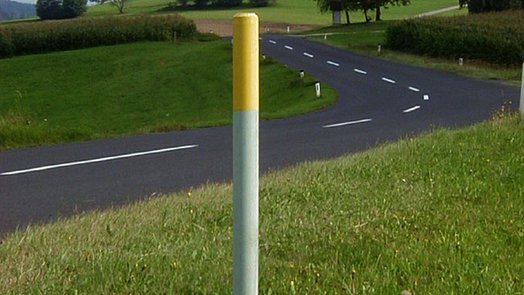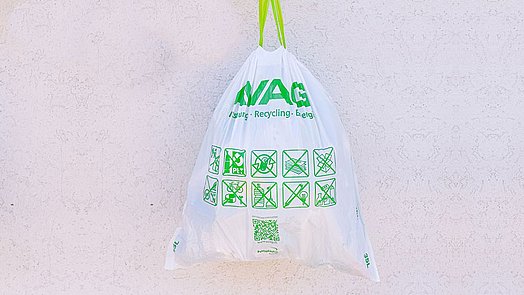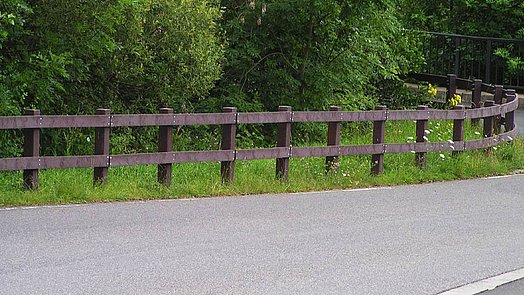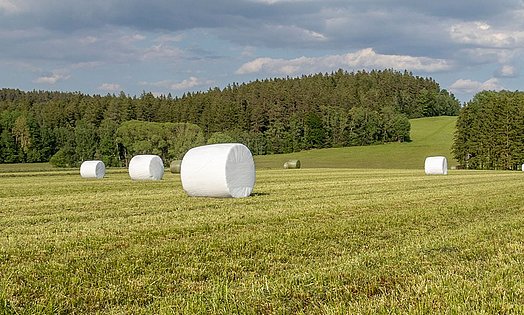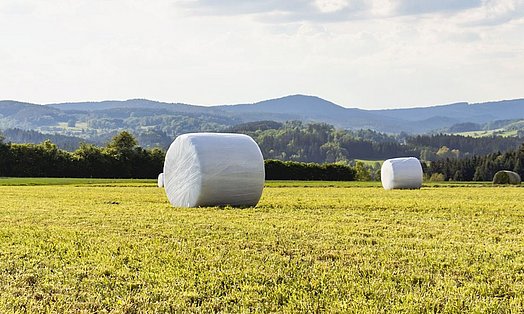Recycling agricultural stretch films
The previous installment of our series about agricultural stretch and wide films focused on the proper storage of film rolls prior to the production of bale silage. This article is now shifting towards the question of what to do with agricultural stretch films after the bale silage has been fed to the animals.
Film recycling
Agriculture is a sector of industry that is close to nature and in which the principle of operating in (material) cycles plays a pivotal role. This principle is paramount both to the preservation of such limited resources as the soil and the environment and to the production of high-quality food. It is, therefore, beneficial to use previously applied agricultural films again by salvaging the plastic, i.e. by feeding it back into the cycle (of materials).
The consensus today is that recycling is the most suitable way of film disposal.
Essential to the refurbishment and reuse of raw materials is the clean separation of the materials that are supposed to be recycled. This requires that the plastic films be subjected to a coarse cleaning and that they be collected separately from the bale nets.
Göweil customers operating with balers that come with our wide film binding unit have a clear advantage in this regard: when cutting open and feeding the bales, they produce only one type of waste - no need to separate the film from the net waste.
The consumables can be collected either in a container on your own farm or at central collection points, largely at regular intervals, and by your local waste management company. The material to be recycled is usually billed by weight or packing unit (e.g. bag or Big Bag).
HOW DOES THE PROCESS OF FILM RECYCLING WORK?
The separately collected portions are first cleaned multiple times at the recycling facilities. The actual processing is then carried out in various steps:
The process begins with a coarse chopping of the material into 60-80 mm large pieces using a shredder.
Next, these film sections are subjected to a sorting process involving cutters, wind tunnels and water baths, which reduces them to ever finer material.
A final reduction produces plastic flakes that are as homogeneous as possible and measure less than 40mm in size. These flakes are melted and pressed (extruded) into granules.
WHAT HAPPENS TO THE RECYCLING MATERIAL?
The granules form the base materials for such recycling products as bags, garbage bags and molded parts (e.g. marking posts), films for packaging material and a host of other products.
Some film manufacturers use the granules for their lines of organic and eco-friendly products and manufacture agricultural stretch films and films for use in gardening and vegetable cultivation from plastic that is up to 100% recycled.
Another fact of interest might be that bright and especially transparent films are easier to recycle than dark films. The processed granulate material simply offers a wider range of application thanks to the greater color flexibility of the recycling products.
Where can I recycle my plastic films?
The best approach is to inquire about the initiatives for the collection and reuse of wrapping and wide films that may be available in your country or region.
A large number of film manufacturers have agreed to share the costs of disposal by promoting such recycling initiatives. As a result, you help finance the recycling with every purchase of the films and will later be charged less per ton of collected film waste than you would for using a film made by a manufacturer who does not partake in the initiative. Best of all, the films are usually not more expensive.
Examples of national initiatives are Farm XS in England, Plasback in New Zealand and Australia, RESI in Switzerland or Cleanfarms in Canada.
Within the EU, the Circular Plastics Alliance was established in 2018. An international association that aims to promote the recycling of plastics on the EU market.
One example of the results this step has produced so far is France, where environmental surcharges added to the sales prices of new plastic products are used to promote the recycling of the plastic materials.
Alternatives to the recycling of plastic films
As mentioned before, recycling is presently the most suitable way to dispose of waste. However, for the sake of completeness, we would like to mention two additional options.
Thermal utilization of silage films
Thermal utilization signifies the incineration of plastics in combined heat and power stations. The process involves the use of a polyethylene film as a substitute fuel for fossil fuels such as oil or coal. Pure PE plastics generate very high temperatures during this process.
The costs involved with this type of disposal vary greatly from region to region. The demand for film as a substitute fuel is significant in some countries, which is why these countries charge only minimal fees or none at all. In other areas, the disposal option at an incineration plant is not available or simply cost prohibitive.Many counters have stopped allowing the incineration of such waste, reducing the available options to film recycling.
Biodegradable alternatives:
The evolving demands of society and the growing knowledge of the problems associated with plastics have given rise to new possibilities. Researchers of several nations have been exploring biodegradable alternatives for agricultural films for quite some time now.
Their efforts have already produced viable solutions in gardening and vegetable growing such as the suppressing of weeds or forced cultivation by means of biodegradable films.
However, biological alternatives have not yet proven competitive in the area of feed preservation on account of their high cost of production.
Notwithstanding, the research findings are promising: one example are films made of polylactic acid, whose resistance to UV resistance, resistance to material damage and gas impermeability closely rival that of established films made of polyethylene.
The trade-offs involved with the use of biodegradable films are immediately apparent:
The film material needs to decompose quickly and completely. On the other hand, the material must be sufficiently resilient to provide for the preservation and storage of the laboriously produced silage bales.
Would you like to learn even more about the production, functionality and basic facts related to the vast field of agricultural films? You will find answers to the most frequently asked questions about stretch and net replacement films in the second installment of our film series. To access the first part of our series on the correct storage of film rolls, click here.
You are also welcome to contact our international sales team to receive answers to any questions you may have on the correct use of the films in the balers and baler-wrapper combinations made by GÖWEIL.
